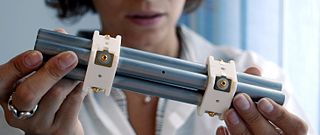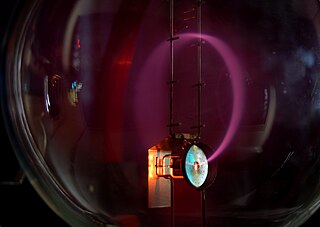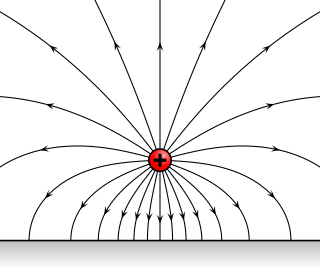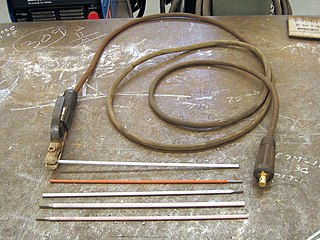Field-emission electric propulsion (FEEP) is an advanced electrostatic space propulsion concept, a form of ion thruster, that uses liquid metal as a propellant. A FEEP device consists of an emitter and an accelerator electrode. A potential difference of the order of 10 kV is applied between the two, which generates a strong electric field at the tip of the metal surface. The interplay of electric force and surface tension generates surface instabilities which give rise to Taylor cones on the liquid surface. At sufficiently high values of the applied field, ions are extracted from the cone tip by field evaporation or similar mechanisms, which then are accelerated to high velocities.

Mass spectrometry (MS) is an analytical technique that ionizes chemical species and sorts the ions based on their mass-to-charge ratio. In simpler terms, a mass spectrum measures the masses within a sample. Mass spectrometry is used in many different fields and is applied to pure samples as well as complex mixtures.
Accelerator physics is a branch of applied physics, concerned with designing, building and operating particle accelerators. As such, it can be described as the study of motion, manipulation and observation of relativistic charged particle beams and their interaction with accelerator structures by electromagnetic fields.

An electron gun is an electrical component in some vacuum tubes that produces a narrow, collimated electron beam that has a precise kinetic energy. The largest use is in cathode ray tubes (CRTs), used in nearly all television sets, computer displays and oscilloscopes that are not flat-panel displays. They are also used in field emission displays (FEDs), which are essentially flat-panel displays made out of rows of extremely small cathode ray tubes. They are also used in microwave linear beam vacuum tubes such as klystrons, inductive output tubes, travelling wave tubes, and gyrotrons, as well as in scientific instruments such as electron microscopes and particle accelerators. Electron guns may be classified by the type of electric field generation, by emission mechanism, by focusing, or by the number of electrodes.
The particle-in-cell (PIC) method refers to a technique used to solve a certain class of partial differential equations. In this method, individual particles in a Lagrangian frame are tracked in continuous phase space, whereas moments of the distribution such as densities and currents are computed simultaneously on Eulerian (stationary) mesh points.
An electrostatic lens is a device that assists in the transport of charged particles. For instance, it can guide electrons emitted from a sample to an electron analyzer, analogous to the way an optical lens assists in the transport of light in an optical instrument. Systems of electrostatic lenses can be designed in the same way as optical lenses, so electrostatic lenses easily magnify or converge the electron trajectories. An electrostatic lens can also be used to focus an ion beam, for example to make a microbeam for irradiating individual cells.

The gridded ion thruster is a common design for ion thrusters, a highly efficient low-thrust spacecraft propulsion running on electrical power. These designs use high-voltage grid electrodes to accelerate ions with electrostatic forces.

An ion trap is a combination of electric or magnetic fields used to capture charged particles, often in a system isolated from an external environment. Ion traps have a number of scientific uses such as mass spectrometry, basic physics research, and controlling quantum states. The two most common types of ion trap are the Penning trap, which forms a potential via a combination of electric and magnetic fields, and the Paul trap which forms a potential via a combination of static and oscillating electric fields.

The quadrupole mass analyzer (QMS) is one type of mass analyzer used in mass spectrometry. It is also known as a transmission quadrupole mass spectrometer, quadrupole mass filter, or quadrupole mass spectrometer. As the name implies, it consists of four cylindrical rods, set parallel to each other. In a quadrupole mass spectrometer the quadrupole is the mass analyzer - the component of the instrument responsible for selecting sample ions based on their mass-to-charge ratio (m/z). Ions are separated in a quadrupole based on the stability of their trajectories in the oscillating electric fields that are applied to the rods.

Electron optics is a mathematical framework for the calculation of electron trajectories along electromagnetic fields. The term optics is used because magnetic and electrostatic lenses act upon a charged particle beam similarly to optical lenses upon a light beam.

A quadrupole ion trap is a type of ion trap that uses dynamic electric fields to trap charged particles. They are also called radio frequency (RF) traps or Paul traps in honor of Wolfgang Paul, who invented the device and shared the Nobel Prize in Physics in 1989 for this work. It is used as a component of a mass spectrometer or a trapped ion quantum computer.
An einzel lens, or unipotential lens, is a charged particle electrostatic lens that focuses without changing the energy of the beam. It consists of three or more sets of cylindrical or rectangular apertures or tubes in series along an axis. It is used in ion optics to focus ions in flight, which is accomplished through manipulation of the electric field in the path of the ions.

The mass-to-charge ratio (m/Q) is a physical quantity that is most widely used in the electrodynamics of charged particles, e.g. in electron optics and ion optics. It appears in the scientific fields of electron microscopy, cathode ray tubes, accelerator physics, nuclear physics, Auger electron spectroscopy, cosmology and mass spectrometry. The importance of the mass-to-charge ratio, according to classical electrodynamics, is that two particles with the same mass-to-charge ratio move in the same path in a vacuum, when subjected to the same electric and magnetic fields. Its SI units are kg/C. In rare occasions the thomson has been used as its unit in the field of mass spectrometry.

In mass spectrometry, Orbitrap is an ion trap mass analyzer consisting of an outer barrel-like electrode and a coaxial inner spindle-like electrode that traps ions in an orbital motion around the spindle. The image current from the trapped ions is detected and converted to a mass spectrum using the Fourier transform of the frequency signal.
An electrostatic analyzer or ESA is an instrument used in ion optics that employs an electric field to allow the passage of only those ions or electrons that have a given specific energy. It usually also focuses these particles into a smaller area. ESA’s are typically used as components of space instrumentation, to limit the scanning (sensing) energy range and, thereby also, the range of particles targeted for detection and scientific measurement. The closest analogue in photon optics is a filter.

Spark ionization is a method used to produce gas phase ions from a solid sample. The prepared solid sample is vaporized and partially ionized by an intermittent discharge or spark. This technique is primarily used in the field of mass spectrometry. When incorporated with a mass spectrometer the complete instrument is referred to as a spark ionization mass spectrometer or as a spark source mass spectrometer (SSMS).

A reflectron is a type of time-of-flight mass spectrometer that comprises a pulsed ion source, field-free region, ion mirror, and ion detector and uses a static or time dependent electric field in the ion mirror to reverse the direction of travel of the ions entering it. Using the reflectron, one can substantially diminish a spread of flight times of the ions with the same mass-to-charge ratio (m/z) caused by spread in kinetic energy of these ions measured at the exit from the ion source.
Biology Monte Carlo methods (BioMOCA) have been developed at the University of Illinois at Urbana-Champaign to simulate ion transport in an electrolyte environment through ion channels or nano-pores embedded in membranes. It is a 3-D particle-based Monte Carlo simulator for analyzing and studying the ion transport problem in ion channel systems or similar nanopores in wet/biological environments. The system simulated consists of a protein forming an ion channel (or an artificial nanopores like a Carbon Nano Tube, CNT), with a membrane (i.e. lipid bilayer) that separates two ion baths on either side. BioMOCA is based on two methodologies, namely the Boltzmann transport Monte Carlo (BTMC) and particle-particle-particle-mesh (P3M). The first one uses Monte Carlo method to solve the Boltzmann equation, while the later splits the electrostatic forces into short-range and long-range components.
Structures for lossless ion manipulations (SLIM) are a form of ion optics to which various radio frequency and dc electric potentials can be applied and used to enable a broad range of ion manipulations, such as separations based upon ion mobility spectrometry, reactions, and storage. SLIM was developed by Richard D. Smith and coworkers at PNNL and are generally fabricated from arrays of electrodes on evenly spaced planar surfaces.

in mass spectrometry, an ion funnel is a device used to focus a beam of ions using a series of stacked ring electrodes with decreasing inner diameter. A combined combined radio frequency and fixed electrical potential is applied to the grids. In electrospray ionization-mass spectrometry (ESI-MS), ions are created at atmospheric pressure, but are analyzed at subsequently lower pressures. Ions can be lost while they are shuttled from areas of higher to lower pressure due to the transmission process caused by a phenomenon called joule expansion or “free-jet expansion.” These ion clouds expand outward, which limits the amount of ions that reach the detector, so fewer ions are analyzed. The ion funnel refocuses and transmits ions efficiently from those areas of high to low pressure.

















